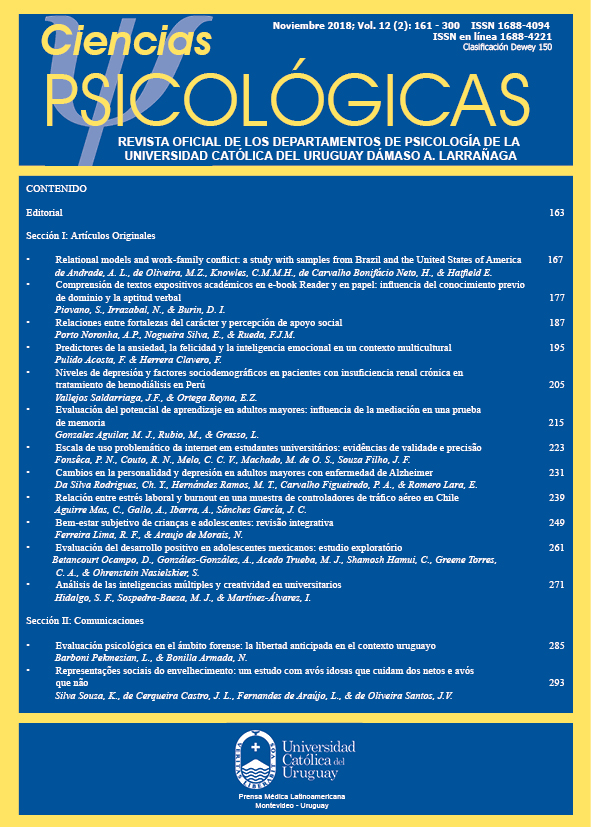Assessment of positive development in Mexican adolescents: exploratory study
DOI:
https://doi.org/10.22235/cp.v12i2.1690Keywords:
positive development, adolescents, psychological assessment, measurement, scaleAbstract
The objective of this study was to design and measure psychometrically an instrument that assesses the positive development of Mexican adolescents. To this end, a non-probabilistic sample of 400 adolescents, selected from secondary school students, 57% were men and 43% were women, with an average age of 13.52 years. Based on the review of the literature, an instrument was designed based on the proposal of Lerner (2004), which comprises 59 items that are grouped into five scales Likert type that evaluate the five characteristics of positive development: Competence (13 items, α= .809), Care (6 items, α= .672), Confidence (11 items, α= .837), Connection (17 items, α= .920) and Character (12 items, α= .854). The results showed that the instrument has adequate psychometric properties for this study. The discussion analyzes the utility of the instrument in the Mexican adolescent population for the assessment of positive development and as an instrument to evaluate the effectiveness of programs promoting healthy development in adolescents.
Downloads
References
Armsden, G. C., & Greenberg, M. T. (1987). The inventory of parent and peer attachment: Individual differences and their relationship to psychological well-being in adolescence. Journal of Youth and Adolescence, 16(5), 427-454. doi: https://doi.org/10.1007/BF02202939
Benson, P. L., Leffert, N., Scales, P. C., & Blyth, D. A. (2012). Beyond the “village” rhetoric: Creating healthy communities for children and adolescents. Applied Developmental Science, 16(1), 3-23. doi: https://doi.org/10.1080/10888691.2012.642771
Bowers, E.P., Li, Y., Kiely, M.K., Brittain, A., Lerner, J.V., & Lerner, R.M. (2010). The five Cs model of positive youth development: A longitudinal analysis of confirmatory factor structure and measurement invariance. Institute for Applied Research in Youth Development, Tufts University.
Eisenberg, N., Fabes, R. A., & Murphy, B. C. (1996). Parents’ reactions to children’s negative emotions: Relations to children’s social competence and comforting behavior. Child Development, 67(5), 2227-2247. doi: 10.1111/j.1467-8624.1996.tb01854.x
Geldhof, G.J., Bowers, E.P., Mueller, M. K., Napolitanto, C. M., Schmid, C. K., Walsh, K. J., Lerner, J. V., & Lerner, R. (2015). The Five Cs Model of Positive Youth Development. En E. P. Bowers, G. J. Geldhof, S. K. Johnson, L. J. Hilliard, R. M. Hershberg, J. V. Lerner, & R. M. Lerner (Eds.) Promotion Positive Youth Development. Lessons from the 4-h Study (pp. 161-186). USA: Springer.
Harter, S. (1983). Supplementary description of the Self-Perception Profile for Children: Revision of the Perceived Competence Scale for Children. Unpublished manuscript, University of Denver.
Heck, K. E., & Subramaniam, A. (2009). Youth Development Frameworks. [Monograph]. Davis, CA. Recuperado de: http://4h.ucanr.edu/files/1224.pdf
Jelicic, H., Bobek, D. L., Phelps, E., Lerner, R. M., & Lerner, J. V. (2007). Using positive youth development to predict contribution and risk behaviors in early adolescence: Findings from the first two waves of the 4-H Study of Positive Youth Development. International Journal of Behavioral Development, 31(3), 263-273. https://doi.org/10.1177/0165025407076439
Lerner, R. M. (2002). Concepts and theories of human development. Mahwah, NJ: Lawrence Erlbaum.
Lerner, R. M. (2004). Liberty: Thriving and civic engagement among America’s youth. Thousand Oaks, CA: Sage.
Lerner, R.M., Lerner, J.V., Almerigi, J.B., Theokas, C., Phelps, E., Gestsdottir, S… von Eye, A. (2005). Positive youth development, participation in community youth development programs, and community contributions of fifth-grade adolescents: Findings from the first wave of the 4-H study of positive youth development. Journal of Early Adolescence, 25, 17-71. doi: https://doi.org/10.1177/0272431604272461
Lopez, A., Yoder, J. R., Brisson, D., Lechuga-Pena, S., & Jenson, J. M. (2015). Development and validation of a positive youth development measure: The Bridge-Positive Youth Development. Research on Social Work Practice, 25(6), 726-736. doi: https://doi.org/10.1177/1049731514534899
Shek, D. T., & Ma, C. M. (2010). Dimensionality of the Chinese positive youth development scale: confirmatory factor analyses. Social Indicators Research, 98(1), 41-59. doi: https://doi.org/10.1007/s11205-009-9515-9
Theokas, C., Almerigi, J. B., Lerner, R. M., Dowling, E. M., Benson, P. L., Scales, P. C., & von Eye, A. (2005). Conceptualizing and modeling individual and ecological asset components of thriving in early adolescence. The Journal of Early Adolescence, 25(1), 113-143. doi: https://doi.org/10.1177/0272431604272460
















